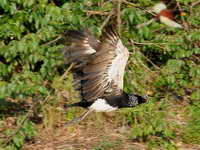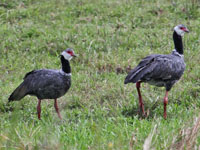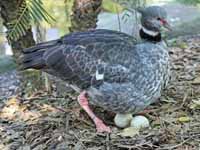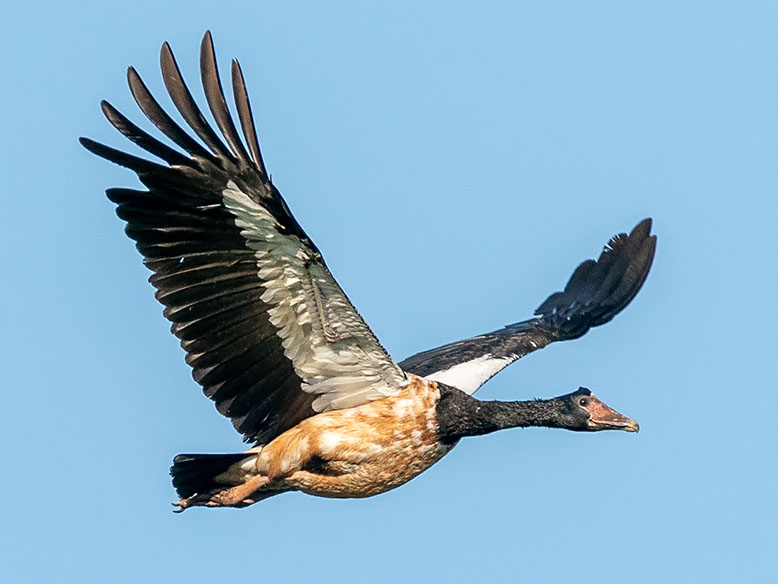The term waterfowl is used to describe any member of the order Anseriformes. A series of articles describes all the waterfowl. This specific article describes the "screamers and magpie goose" which belong to family Anhimidae and family Anseranatidae respectively.
Anseriformes
Most species of the order Anseriformes spend a considerable amount of time in water. In fact, they are called waterfowls. Their webbed feet make for efficient swimming. A few species spend little time in water and thus their feet are only partially webbed. Most waterfowl are also good flyers, many migrating long distances to escape the cold and others migrating shorter distances for optimizing their food supply. All species, except the screamers, have a wide and relatively flat bill. The shape of a species bill and also their tongue is a function of their diet. Considering the entire order, they eat aquatic plants, grasses, sedges, algae, plankton, insects, insect larvae, mollusks, crustaceans, fish, fruits, grains, rice. Most species are monogamous and if they lose a partner seem to mourn. Males are larger and heavier than females. The chicks are well developed when they hatch and can walk almost immediately.
Family Anhimidae - Screamers
Family Anhimidae
The screamers are a small family of birds related to ducks (family Anatidae), but more closely to the magpie goose which is the only species in family Anseranatidae. The three Anhimidae species occur only in South America, ranging from Venezuela to northern Argentina. They are so named for their loud calls. They are large, bulky birds, with a small downy head, long legs and large feet which are only slightly webbed. In fact, the screamers have the least webbing on their feet of any members of Anseriformes. Their bill is more like that of a chicken or hawk than it is duck-like. They have large spurs on their wings which are used in fights over mates and territorial dispute]; these can break off in the breast of other screamers, and are regularly renewed. Unlike ducks, they have a partial moult, and are able to fly throughout the year. The young, like those of most Anseriformes, can run as soon as they are hatched. They live in open areas and marshes with some grass and feed on water plants. The southern screamer is often kept as a guard animal because of its loud call, it is not a fussy eater, and it imprints on its caregiver at birth.
Genus Anhima - 1 species
Screamer, Horned Anhima cornuta
Description: The horned screamer has dark .grey upperparts.The head is black with white speckles. It's bill is more hawk-like than duck-like.The neck is mottled .grey and white. It has a white white belly and under-wings. There is a thin horn-like projection on the head which led to the name "horned". The screamer's call is very loud.
Range: South America.
Habitat: Lowlands , especiaaly well vegetated marshes.
Diet: Grasses, not aquatic plants.
Conservation status: Least concern.
Image by: 1) Diego Miguel_Garces 2) Bradley_Hacke in Peru 3) Cláudio Timm - the Amazon, BrazilRange: South America.
Habitat: Lowlands , especiaaly well vegetated marshes.
Diet: Grasses, not aquatic plants.
Conservation status: Least concern.



Genus Chauna
Screamer, Northern Chauna chavaria
Description: The northern screamer, also known as the black necked screamer, has a dark .grey body, black neck, and a diagonal white band from the back of head to chin. It hs a .grey crown and forehead.
Range: South America in northern Columbia and northwest Venezuela.
Habitat: Swampy lowlands with with trees for roosting. It builds its nest in the middle of a marsh.
Diet: Aquatic plants. grazes.
Conservation status: It is near threaten becuase of habit challenges. It is relatively rare and not kept in many zoos.
Image by: 1) Petruss - Columbia 2) Nick Athanas - Columbia 3) anthrotectRange: South America in northern Columbia and northwest Venezuela.
Habitat: Swampy lowlands with with trees for roosting. It builds its nest in the middle of a marsh.
Diet: Aquatic plants. grazes.
Conservation status: It is near threaten becuase of habit challenges. It is relatively rare and not kept in many zoos.



Screamer, Southern Chauna torquata
Description: The Southern Screamer, also known as the crested screamer, has .grey upperparts. The grey head has a crest at the rear. The neck has a fuzzy black ring with a smaller white collar above. The neck is similar to that of the northern screamer, but the black area is much narrower. It has light .grey underparts. The southern screamer is often kept as a guard animal because of its loud call, it is not a fussy eater, and it imprints on its caregiver at birth. It is a good swimmer and strong flyer.
Range: South America.
Habitat: Grasslands, culitvated fields, marshes, swamps.
Diet: Plants stems, seeds, leaves, and, rarely, small animals.
Conservation status: Least concern.
Image by: 1 ) Dick Daniels - Jacksonville Zoo 2, 3) Cláudio Timm - - Tacuarembó,
Uruguay 4) Dick - San Diego Zoo 5) Cristiano Crolle - Range: South America.
Habitat: Grasslands, culitvated fields, marshes, swamps.
Diet: Plants stems, seeds, leaves, and, rarely, small animals.
Conservation status: Least concern.





Family Anseranatidae - Magpie Goose
The magpie goose is the only species in family Anseranatidae. This family belongs to order Anseriformes which is the same order as family Anhimidae (the 3 screamers) and family Anatidae: ducks, geese, and swans. The family is quite old. It probably existed before the extinction event that ended the rule of the dinosaurs about 6 6 million years ago. It evolutionary path diverged from a common ancestor after the screamer family, but before the ducks, goose and swan family.
Genus Anseranas - 1 species
The magpie goose diverged from the other waterfowl tens of millions of years ago, but it does have the general look of a goose. With its black and white plumage is aptly named.
Goose,_Magpie Anseranas semipalmata
Description: The Magpie Goose has a black head and neck,It has a black and white body, orange-yellow legs and feet. The feet are partially webbed. Unlike true geese, their moult is gradual, so no flightless periods result.
Range: Australia, New Guinea
Habitat: Wetlands such as swamps, marshes, and floodplains.
Diet: Grasses, seeds. They also use their bill to dig bulbs from the ground.
Conservation status: Least concern.
Image by: 1) Dick Daniels - Australia 2) JJ Harrison - Northern Territory, Australia. 3) Geoff_Whalan - North West Territory 4) David_Cook - Northern Territory 5) Dick - Sylvan Heights Range: Australia, New Guinea
Habitat: Wetlands such as swamps, marshes, and floodplains.
Diet: Grasses, seeds. They also use their bill to dig bulbs from the ground.
Conservation status: Least concern.
5) Partially webbed feet




